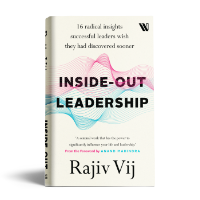
Photo by Dreamstime
Do you often get feedback that, as a leader, you are delivering healthy results, but not making enough impact? Do you feel that despite your performance, you run the risk of being overlooked for a promotion? Are you running out of ideas to get noticed and be counted?
You are not alone. A number of leaders respond in positive to at least one of the above questions. Many a time, the skills that helped you get to the current level of success may not be the ones that help you get to the next. Here are five ideas you can consider working on to make greater impact, get on top of your game and get recognized with all the rewards you deserve.
1. Three things that matter
Making impact is about making strategic contribution – delivering steady results in your defined role, while important, by itself hardly qualifies for that. To start making impact, you need to be more strategic in your approach to your role – be able to look at the big picture of your landscape and identify a handful of priorities that would make the greatest difference in 12-18 months or longer.
I find limiting your focus to the top three priorities most productive – three is not too many and yet it’s high enough for the results to count. While considering these priorities, think not of tasks, but of processes; not of processes, but of structures; not of your annual goals, but of the longer-term mission of the organization; not of the transactional, but of the transformational.
Further, to manifest these priorities into reality, and to avoid the risk of being consumed by short-term goals or the 24/7 gadgetry stimuli, consider creating non-negotiable time windows upfront in your calendar on a weekly basis to progress on these priorities. Most impactful leaders spend upwards of two-thirds of their time on their top three priorities. Furthermore, for being impactful, choose adopting this approach to every interaction you have, with seniors, peers or team members – paying attention to the underlying strategic issue you are trying to address and the longer-term impact of your present actions.
2. Delegation paradigm
As a leader, to be able to focus on your top priorities requires being strong at delegation. Even leaders who generally consider themselves good at delegation generally tend to delegate what they can’t do – not what they lack competence in, but what they don’t have time for. It’s the overflow of their work.
Leaders who are exceptional at delegation follow a different paradigm though – they don’t delegate what they can’t do, they do only what no one else can. Whatever work flows to them, their first instinct is to determine who in their team can do it – that ensures that much of the BAU stuff gets attended by the team, leaving the leader to focus on the big ticket agenda.
Ask yourself, if you had to (assume a hypothetical personal crisis that requires your attention), what three things would you stop doing? How about initiating that now? As Peter Drucker said, ‘Half the leaders I’ve met don’t need to learn what to start doing, but what to stop.’ Do you have to personally attend all the meetings and calls that you attend; can someone else in your team attend some of them? What about being restless around pending checklist and persistently following-up?
3. Limiting personality traits
Being strategically focused and delegating aggressively requires three key personality shifts – learning to let go, not seeking perfection, and learning to say NO.
Perfectionism is revered in organizations, particularly at the junior and middle management levels. It allows seniors to confidently rely on you. However, the same trait becomes a drag at leadership positions. As Warren Bennis observed, ‘Managers do things right, leaders do the right things.’ Impactful leaders focus on the issues, projects, and pursuits that make a significant difference. They also recognize that everything doesn’t need to be at a ‘platinum’ level – they are comfortable with letting some things be at ‘gold’ and some at even ‘silver’ level.
This requires learning to let go. Similarly, delegating to others who may not produce work at exactly the same level of perfection as us tests our ability to let go of our fixed expectations. Further, for you to equip yourself to be effective at managing your priorities and time, particularly if you tend to be permissive and accommodating by nature, you have to learn to say NO – no to meetings or calls you don’t necessarily need to attend; choosing to push back seniors and others when they make unreasonable demands on your time.
4. Consistent messaging
While working through the above approach should put you in a stronger position to make impact, if you are uncomfortable with messaging your ideas or progress to your wider stakeholder network, it can hold you back – especially relevant in the Asian context where ‘content’ is considered supreme, and ‘form’ is almost looked down upon.
As much as organizations, even the most successful ones, need to advertise, leaders need to actively talk about their ideas and actions to their stakeholder network. Like with the ads, you need to persist with communicating a consistent message. For example, as you pursue your top priorities, actively communicate about them through the journey – right from the planning stage to regular updates to when you accomplish your objectives. This consistent messaging would not only allow you to get appropriate resources and support for your ideas, it would also build a fair and strong association between those accomplishments and you.
Further, if you are not a natural conversationalist, I recommend preparing three types of messaging, in sync with your priorities: the elevator pitch (a two-minute message about one of your top priorities that you would like to communicate when someone very senior politely asks you, ‘How’s it going?’), a ten-minute message (that covers the headline of your top priorities) and a thirty-minute message (describing the significant progress on your three priorities) for someone who’s keen to know more about your work.
5. Executive presence
Finally, there’s the intangible but potent space of executive presence. Making impact invariably necessitates influencing others, many a time without authority; besides the quality of your ideas, executive presence can support you with that. Again, in Asian culture where being understated and withdrawn is not unusual, paying attention to this aspect is important.
It encompasses developing gravitas – most importantly, how you show up and how you communicate. Appearance, confidence and poise, positive and energized body language as well as speaking well, having a point of view and being able to communicate it assertively, listening well and being perceptive of the sensibilities of others around – are all facets of this presence. Besides, being your authentic self, confidently comfortable in your own skin, and being curious is powerful.
Surely some people are gifted with this, but with greater self-awareness and observing others who are good at it, most leaders can enhance their presence and visible impact.











 This New Year: Change The Conversation With Your Inner Child
This New Year: Change The Conversation With Your Inner Child Are You A Maximiser Or A Satisficer? The Answer Shapes Your Life
Are You A Maximiser Or A Satisficer? The Answer Shapes Your Life Can’t Go Outside? Try Going Inside
Can’t Go Outside? Try Going Inside My Struggles With Hitting A Stationary Ball: 5 Life Lessons I Learnt From Golf
My Struggles With Hitting A Stationary Ball: 5 Life Lessons I Learnt From Golf 3 Steps To Highly Engaged Employees
3 Steps To Highly Engaged Employees
Are you sure this is what you wanted to say here (Processes are to be both thought of and not thought of:?)
While considering these priorities, think not of tasks, but of processes; not of processes, but of structures;
Hey Dhruv: Good to hear from you. Yes, the reason I put it that way to highlight the opportunity to think at a broader level, depending upon where you are right now. If you are currently more task-focused, consider being process-focused; if you are currently involved with processes, consider working on structures. Kind regards, Rajiv